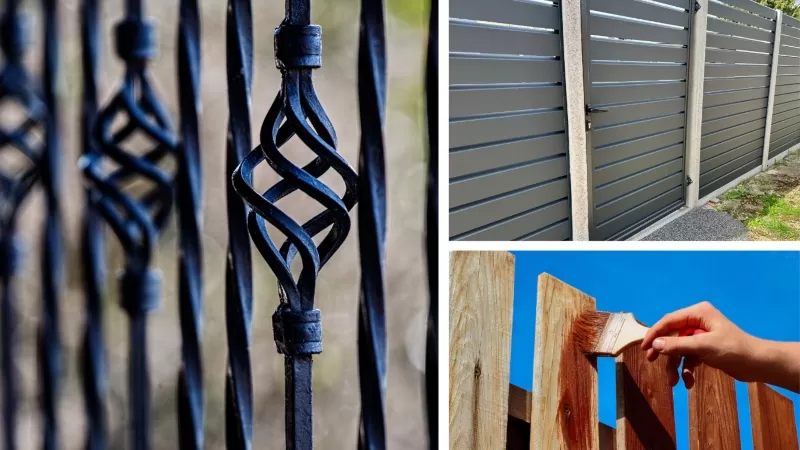Why Fencing Matters More Than You Think
We’ve experienced more than our share of wildfires in Northern California. According to the Marin County Fire Chiefs Association’s Marin Fire History Project, wildfires have played a significant role in Marin County almost since its inception in 1850. The first major wildfire raged in 1852. The biggest concern today is in the wildland urban interface (WUI) areas, where suburban homes and businesses butt up against open spaces and wildland vegetation.
- Up to 60% of home ignitions during wildfires are caused by embers or direct flame contact with attached structures.
- A surprising ignition source: fences and gates can act like fuses.
How Fires Spread: The Fence-to-Home Connection
If the fire department arrives at your home for a fire-safe inspection, and you have a wooden fence or gate that connects to your home, be prepared for wise words of advice. Remove it or treat it. Why? Because they know that wooden fences and gates are the connective tissue fires use to ignite structures. Once in flames, these gates and fences can ignite siding or allow the fire to enter through vents and windows.
The whole point of creating a defensible space is to maintain a clear, non-combustible zone around your home, that includes removing not only flammable vegetation and debris; it also means the removal or treatment of wooden fences and gates that attach to your home.
- CAL FIRE and IBHS studies demonstrate how wooden fences have contributed to structure loss in past wildfires.
The Science of Safety: What Makes a Fence Fire-Resistant?
Key qualities of a fire-resistant fence are that it is noncombustible, ignition-resistant, and ember-resistant. If you are planning on adding fencing to your home, considerations for a fire-safe design include fence layout, spacing from the home, gate design, and metal hardware.
Fire-Resistant Fencing Materials: Options Beyond Wood
The variety of fire-resistant fencing is greater than you might imagine. Fire-Safe Marin lists many of these options on their website:
- Metal (Steel or Iron) because it is:
- Durable, stylish, and noncombustible.
- Powder-coated options provide added aesthetics.
- Concrete or CMU Block Fencing because it is:
- Effective for privacy and fire protection.
- Can be combined with metal accents or caps.
- Composite Fencing because it is:
- More environmentally friendly as it is made from recycled materials.
- Some are rated for ignition resistance but be sure to check specs carefully.
- Fiber Cement Fencing Panels because they are:
- Made from the same material that is used for fire-rated siding.
- Highly fire-resistant and require minimal maintenance.
- Treated Timber (for select sections only) because it is:
- Class A fire-retardant-treated wood that can be used, if necessary, but should not touch the home.
- Gabion Walls (rock-filled wire cages) because they are:
- Modern, rustic aesthetic and fully noncombustible.
- Tempered Glass or Metal Mesh Gates because they are:
- Contemporary and allow visibility, while resisting heat and ember entry.
What If You Already Have a Wooden Fence or Gate Attached to Your Home?
Fire-Resistant Treatments and Retrofits
If you’re not ready to replace your wooden fencing or gate, there are steps you can take to make it more ignition resistant.
You or a handyperson can apply fire-retardant coatings to the wood. These come in clear or tinted paints, sprays, or stains that are designed to slow a fire’s ignition and the spread of flame. These applications include intumescent coatings that expand when exposed to heat, creating a protective char layer. Another option is to use penetrating fire-retardant wood treatments designed to soak into the wood and reduce flammability. Your local paint or hardware store can suggest something that is best for your location. They can also explain which ones can be sprayed or brushed on, depending on the product, and which applications require a professional to apply them.
Add Ember-Resistant Features
- Install metal flashing at the base where the fence meets your home.
- Replace or shield any wooden latches, hinges, or posts at the house connection with noncombustible hardware.
- Use tight-fitting, metal mesh screens to keep embers out of gaps and joints.
How Often Do Fire-Retardant Treatments Need Reapplying?
Most treatments need to be reapplied every 2–5 years, depending on:
- UV exposure (sunlight can degrade the treatment)
- Rain and moisture
- Whether the wood was previously painted or sealed
- Always check the manufacturer’s guidelines
Some products include a color-change indicator to help you know when to reapply.
Three Pro Tips:
- Clean the fence thoroughly before applying any treatment.
- Combine fire retardant coatings with regular defensible space maintenance: clear debris, trim nearby vegetation, and check for dry rot or damaged boards.
- Keep leaf litter, bark mulch, or combustibles away from the fence base—this is often where fires ignite.
Best Practices for Marin County Residents
- Keep at least 5 feet of noncombustible zone around your home – this includes fencing.
- Ensure fences and gates do not connect directly to the structure with combustible materials.
- Use metal gates or install a metal section where a fence meets the house.
- Maintain your fencing: remove debris, repair gaps, and inspect hardware.
Local Insight: What Marin Residents Need to Know
Particular neighborhoods and communities contain topography and vegetation that make them especially vulnerable to fast-moving wildfires. These areas are experiencing increasing scrutiny from the insurance industry. Homes with fire-resistant features may qualify for coverage or discounts. Keep this in mind and make your current or potential insurer aware of your efforts to keep your home as fire defensible as possible. Be sure to review the Firewise Communities and defensible space regulations.
Upgrade the Perimeter, Protect the Core
Fire-resistant fencing isn’t simply a cosmetic choice – it’s a critical piece of home hardening and safety. If you are uncertain about the best options for your home’s design and location, don’t hesitate to consult with a fire-safe landscape or building professional.
Remember, it’s not just what’s inside the fence that matters—it’s how the fence holds up when the heat is on.


